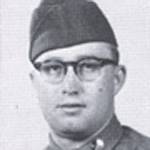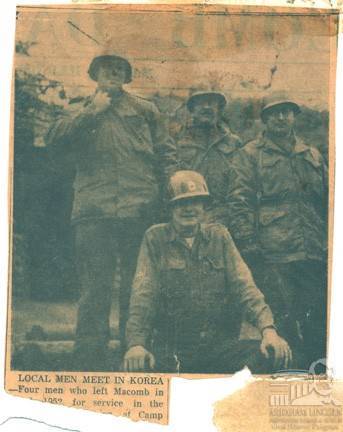Take me back to the Oral History landing page.
Lou Myers - Korean War

Louis 'Lou' Myers came of age on a small subsistence style farm in west central Illinois. He joined the Illinois Army National Guard in 1948, and trained as an artilleryman for the 44th Infantry Division. His unit was mobilized in 1952, and upon arriving in South Korea, Myers was assigned to serve as an advisor with the 8th ROK Division. Myers soon became an artillery 'Jack of all trades', working with the Koreans on all aspects of delivering artillery fire.
Interview Links
Feature Excerpt
Christmas
Abstract
Interview Session 01 (Audio)
Korean War advisor to 8th ROK division artillery
Interview Session 02 (Audio)
Reflections on Korea, & return in 1987
Photos

Caption
Louis Myers in the 44th Infantry Division Artillery Yearbook, published while the unit was undergoing training prior to deployment overseas. The 44th never deployed as a unit. The soldiers were used as individual replacements for units in Korea.
Where:
Camp Cooke, California
When:
1952
Ownership:
This image is considered to be in the public domain.

Caption
A picture of four sons of Macomb, Illinois made the hometown paper, the Macomb Daily Journal in 1953. In front is SFC Lee Terhua, and in back from left to right are Duncan Reed, Richard Ring and SFC Lou Myers.
Where:
Korea
When:
1953
Ownership:
May be restricted. Patrons desiring to use this photograph should contact the ALPL Audio-Visual Curator.

Caption
A view of the Main Supply Route (MSR) heading up to the front inearly 1953.
Where:
Unknown
When:
early 1953
Ownership:
Narrator’s photo

Caption
A view of the Kumsong River winding through the valley, looking east, as it appeared in the winter of 1952-53. The Chinese either attacked down the ridgelines or through the river valley.
Where:
Kumsong River Valley in China
When:
Winter of 1952-53
Ownership:
Narrator’s photo

Caption
ROK soldiers train on a 90 millimeter gun in early 1953, at a fire base north of the Kumsong River.
Where:
North of the Kumsong River, China
When:
Early 1953
Ownership:
Narrator’s photo

Caption
Lieutenant Kim, the 9th Artillery Group’s G-2 with a 90 mm gun crew laboring behind him.
Where:
China
When:
Unknown
Ownership:
Narrator’s photo

Caption
A front line trench is visible on the crest of Finger Ridge, near Kumsong. This was in the 8th ROK Division, II ROK Corps sector of the line. The Chinese were roughly 300 yards to the north.
Where:
Finger Ridge, near Kumsong
When:
Unknown
Ownership:
Narrator’s photo

Caption
The rugged and barren terrain that characterized the front lines in Korea. Note the trench lines on the rear slope, and the absence of vegetation.
Where:
Korea
When:
Unknown
Ownership:
Narrator’s photo

Caption
Christmas, 1952 at the front. Lieutenant Kim stands in front of a 9th Artillery Group bunker festooned for the holiday. Many Koreans were interested in Christianity, and asked Myers to teach them about the religion.
Where:
Unknown
When:
Christmas, 1952
Ownership:
Narrator’s photo

Caption
Korean Service Corps (KSC) personnel working on the mail supply route (MSR) to the front lines in the spring of 1953.
Where:
Unknown
When:
Spring of 1953
Ownership:
Narrator’s photo

Caption
A view of No-Mans Land from a bunker. SGT. Myers was calling in 8 inch artillery fire on the white spot visible in the center-right of the photo. It marked the location of an enemy 75 mm gun position hidden in a cave except when hauled out to fire.
Where:
South Korean
When:
Unknown
Ownership:
Narrator’s photo

Caption
The entrance to a ROK 105 millimeter howitzer artillery position, the closest artillery position to the front lines.
Where:
Unknown
When:
Unknown
Ownership:
Narrator’s photo

Caption
ROK (Republic of Korea) infantry on their way to the front. Once there, the troops lived in caves or bunkers carved into the back side of the mountains.
Where:
Unknown
When:
Unknown
Ownership:
Narrator’s photo

Caption
Korean peasants working in a rice paddy in the spring of 1953.
Where:
Unknown
When:
Spring of 1953
Ownership:
Narrator’s photo

Caption
A typical Korean village nestled into a rugged hillside Near Chunch’on, in the spring of 1953.
Where:
Near Chunch’on, Korea
When:
Spring of 1953
Ownership:
Narrator’s photo

Caption
A Korean in the spring of 1953 is loaded down with an ubiquitous A-frame, the way most goods and supplies were transported near the front lines, where very few pack animals or vehicles were used.
Where:
Unknown
When:
Spring of 1953
Ownership:
Narrator’s photo

Caption
Children started their training on A-frames at an early age.
Where:
Unknown
When:
Unknown
Ownership:
Narrator’s photo

Caption
Korean women used local rivers to do their laundry. In the spring, these rivers were often icy cold.
Where:
Unknown
When:
Unknown
Ownership:
Narrator’s photo

Caption
The 12th Field Artillery Group’s Chaplain’s tent, where Myers often assisted the ROKs, during the spring of 1953.
Where:
Unknown
When:
Spring of 1953
Ownership:
Narrator’s photo

Caption
Seoul as it appeared in the spring of 1953, two years removed from the battles that decimated the city in 1950 and 1951. Myers was visiting the city on R&R
Where:
Seoul
When:
Spring of 1953
Ownership:
Narrator’s photo

Caption
Accordionist Dick Contino and his band. The group was one of many entertainers who traveled to Korea to entertain the troops. Contino was a conscientious objector who sought other ways to serve his country.
Where:
Korea
When:
Unknown
Ownership:
Narrator’s photo

Caption
A typical street scene in Pusan as it appeared when Myers was redeploying in September, 1953. The city was a major point of debarkation and embarkation throughout the war.
Where:
Pusan, Korea
When:
September, 1953
Ownership:
Narrator’s photo

Caption
The envelope to the letter SFC Myers wrote to the family back in Illinois, where he described the last big communist offensive of the Korean war. The armistice ended it all on July 27, 1953.
Where:
Unknown
When:
Unknown
Ownership:
Narrator’s photo

Caption
Page 1 of the letter SFC Myers wrote to the family back in Illinois, where he described the last big communist offensive of the Korean war. The armistice ended it all on July 27, 1953.
Where:
Unknown
When:
Unknown
Ownership:
Narrator’s photo

Caption
Page 2 of the letter SFC Myers wrote to the family back in Illinois, where he described the last big communist offensive of the Korean war. The armistice ended it all on July 27, 1953.
Where:
Unknown
When:
Unknown
Ownership:
Narrator’s photo

Caption
In 1987 Lou and Polly Myers visited South Korea’s Peace Village at Panmunjom, the site of the still ongoing peace talks. This is a shot of the American observation tower.
Where:
South Korea’s Peace Village at Panmunjom
When:
1987
Ownership:
Narrator’s photo

Caption
United Nations buildings at Panmunjom in 1987, where the peace talks are held, are visible in the foreground, with a North Korean building visible in the background. The building is nothing but a façade, twelve feet deep.
Where:
United Nations buildings at Panmunjom
When:
1987
Ownership:
Narrator’s photo

Caption
Former Illinois State Senator Robert Mitchler with his son John stand next to the table where Mitchler worked as a stenographer for the armistice talks in late 1952. He was part of the group with Lou and Polly Myers visiting Panmunjom in 1987.
Where:
Panmunjom
When:
1987
Ownership:
Narrator’s photo

Caption
Visible in the center is the tallest flagpole in Korea, in North Korea’s Peace Village. Every day the North Koreans bussed in ‘civilians,’ who returned to their real homes at night. Huge speakers pointed south regularly played propaganda.
Where:
The view north from Panmunjom.
When:
1987
Ownership:
Narrator’s photo

Caption
Lou and Polly Myers are dressed in traditional Korean garb during a visit to the Korean Emperor’s temple near Seoul in 1987. A grateful South Korean government picked up much of the tab for returning Korean War veterans.
Where:
Korean Emperor’s temple near Seoul
When:
1987
Ownership:
Narrator’s photo

Caption
Some of the building in 1987 being constructed for the upcoming 1988 Seoul Olympics, a dramatic symbol of how far South Korea had come since the war.
Where:
South Korea
When:
1987
Ownership:
Narrator’s photo

Caption
A statue of General Douglas MacArthur in Inchon, Seoul’s port city.
Where:
Inchon, Seoul’s port city
When:
Unknown
Ownership:
Narrator’s photo

Caption
Lou Myers was named Veteran of the Month in May of 2006 for his help in drafting legislation benefiting veterans and their families. Veterans Affairs Director Roy Dolgos made the presentation.
Where:
Unknown
When:
May of 2006
Ownership:
This image is considered to be in the public domain.

Caption
SFC Myers was awarded this certificate, prepared in both Chinese and English, from the commanding general of the 8th South Korean Division, Major General Chang Do Yong, at the conclusion of hostilities in August, 1953.
Where:
Unknown
When:
August, 1953
Ownership:
This image is considered to be in the public domain.